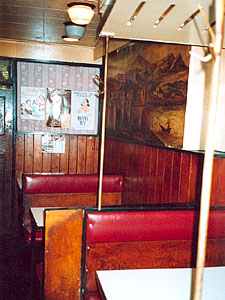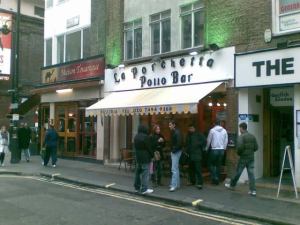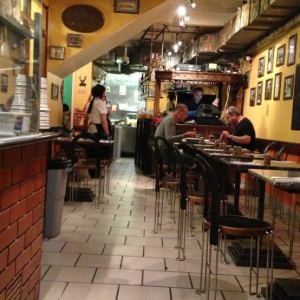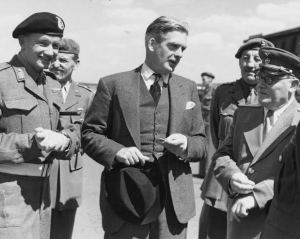Soho (needless to say)
I’m alone on your streets on a Friday evening
I’ve been here all of the day
I’m going nowhere with nowhere to go
Al Stewart, 1972
… it felt like we had one toe in the Mediterranean, even though it was January and our fingers were numb under our gloves …
Deborah Levy, The Man Who Saw Too Much
Sometimes, out of the blue, a message from the old country triggers happy memories and sends us wandering through “the foggy ruins of time”. An old friend from my London days emailed me the other day, recalling how back in the day, I’d frequent a cheap and cheerful Italian café in Soho – what was then “swinging” London’s seedy, sexy and infinitely interesting red-light, hip-boutique and cool restaurant mecca. She’d laid down one wintry English afternoon to relax with a novel, and to her surprise, two pages were dedicated to that very same café.
So, as often happens these days, I was soon flicking through my back pages and disappearing through the smoke rings of my mind.
Cut to 1967 and pictures of a gone world …
The café at the end of the M1
As I wrote in a recent trawl through my back pages (OK! Enough with the Bob Dylan already!):
.“… that motorway from Brum to London was a road well-traveled. In my final year at Moseley Grammar, I’d often hitch down to London for a weekend with pals who’d gone there before. We’d hang out at cheap and cheerful Pollo’s Italian restaurant in Old Compton Street in Soho and the Coach and Horses across the road, and go to Cousins folk and blues joint in a cellar in nearby Greek Street, and the 101 Jazz Club off Oxford Street. Bunjies folk cafè and Ronnie Scott’s jazz club were just around the corner. After a meal or a pint, I’d often catch the last tube to the end of the line closest to the M1. I can’t recall how many times I headed off into the night; and there were always drivers on the road at the witching hour. I guess many folks “get the urge for going”, as Joni sang back then, “and they had to go …” And in those generous times, people were happy to offer a lift to a wayfaring stranger – gentle souls who would not leave strays stranded by the dark wayside; lonesome folks seeking company and conversation in the dark night of the soul; curious people wondering why a young man would hitch the highways in the middle of the English night”.
Yes, Café Pollo was indeed a significant landmark of my London days.
I discovered Café Pollo in the Spring of 1966 when I’d first hitched to London with school friends to take part in a Campaign for Nuclear Disbarment march. From ‘66 through ‘71, I’d go there whenever I was in town, and regularly when I ended up living there – right up to my departure for Australia in 1978. When I was studying at the School of Oriental and African Studies, I’d go there for lunch after Friday classes with my best mate and soul brother Mike (we were born on the same day in the same year in a British city beginning with B).
So, for years and years I’d hung out at Pollo’s. Dined there, boozed there, courted there – almost always on spaghetti bolognese and Chianti with a sticky rum baba to follow. It was crowdy, noisy and smokey, and in winter, steamy and clammy – and “cheap as… “
Though I’d left Old England’s shores, I’d visit Pollo’s whenever I returned and catch up with old pals. When I became vegetarian, the bolognese was replaced with pesto pasta liguria or arrabbiata. When The Evening Standard and Time Out recommended it as an excellent “cheap eats”. I thought its glory days of low-key popularity were over. But it was always there, the same as it always was. The feature picture of this post was taken, I think, when Adèle and I were in England in 1987 – I still have that old Chinese denim jacket and use it for sitting around our bonfires in wintertime.
We continued to go there until 2005, when we were denied service as we just wanted a cup of coffee. The next time I popped by, in September 2008, it was gone. Indeed, it had closed soon after our disappointing coffee quest. Having served the impecunious for generations, it was, in the words of a classic London cafés blog, dismantled and dumped, to be born again as a classier, impersonal, cut-out trattoria – La Porchetta Pollo Bar.
But at least, the name and the memory live on …
Cheap, cheerful and unchanging …
Classic Cafés published an excellent obituary to this Soho icon. Here are some extracts:
“The Pollo, at 20 Old Compton Street, with its ox-blood booths, lapidus beanpole railings, contemporary ceiling, murals, top notch signage, and perfectly preserved light fittings always had hungry queues waiting outside. It remained the proverbial Soho institution for as long as anyone could remember. A proper bargain Italian with perfect ‘60s decor, friendly banter and a worryingly high turnover of chefs (there always seemed to be a ‘chef wanted’ sign in the window). “Cheap and cheerful” remains the operative term at the long-standing Italian café Pollo …
… The almost endless hand-written choice of pastas has now been typed up for easier interpretation, but otherwise the menu remains much the same as I remember it being 20 years back. The food is still hearty, the prices are laughable for central London, the coffee is rocket fuel – and the waitresses still insist on doubling you up in the booths with complete strangers …
… Plenty has changed in London. Fortunately, Pollo hasn’t … The Pollo often finds its way onto the ‘top cheap London eats’ lists, and it was the Evening Standard listing under budget eating that first nudged me in its direction a few years ago… It isn’t fancy. It is an Italian restaurant. The inside looks something like a truckers’ caff, with formica tables and little booths, and there is more room downstairs if it looks full. There isn’t a lot of space and the tables are packed in, but the food is good. The main courses consist of a variety (unsurprisingly) of pasta and pizza dishes, again the price range for these tends to be between £3 – £5. There are some risottos as well, and some meat dishes, such as chicken with rice or veal which are a bit more expensive”.
One toe in the Mediterranean …
As for the book my London friend was reading, which inspired her email and my jaunt down the rabbit hole (a pleasant one), The Man Who Saw Everything by Deborah Levy, here’s what the protagonist had to sat about about our café de coeur:
“In late January 1989, Jennifer and I were sitting in a cheap Italian restaurant called Pollo in Old Compton Street, Soho. It was always full of students from Saint Martin’s our school around the corner because it offered its loyal impoverished customers three courses for a fiver. Jennifer had introduced me to Pollo when we first met. Once we discover spaghetti vongole and penne arrabbiata, it felt like we had one toe in the Mediterranean, even though it was January and our fingers were numb under our gloves … She devoured a plate of spaghetti bolgnese even though she was supposed to be a vegetarian. While she drank water, I knocked back carafe of red wine and ordered another one …. it was warm inside Pollo. Everyone was smoking and shouting us the waiters thumped plates steaming pasta on the formica table. A young man with a blue mohican was stubbing his cigarette in the avocado that had arrive on a plate. it was stuffed with something pink’.
Al Stewart’s Soho (needless to say …)
Apropos the song quoted at the beginning of this memories, whenever I recall Soho in the sixties, I always think about my bedsitter days in London to the early seventies and also, British singer-songwriter and musician Al Stewart’s over-orchestrated debut album of 1967, Bedsitter Images. I knew Al Stewart’s London ‘ere I first knew London. I bought the album when I first saw him perform at the famous Jug o’ Punch folk club in Digbeth, Birmingham, run by The Ian Campbell Folk Group (I also saw a teenage Joni Mitchell play there – it was love at first sight, and I bought her first album there too, Songs from a Seagull). Al may have autographed his record – I can’t recall. It was stolen from my bedsit room in Reading in 1970 along with many of my favourite discs.
Maybe it’s about what here in Australia that, borrowing from our indigenous compatriots, we might call “spirit of place” – the association with the streets within a hop, skip and an amble from Old Compton Street out into Shaftsbury Avenue and that bookshop in Charing Cross Road, the opening verse of the second track Swiss Cottage Manoeuvres, and that flat in Swiss Cottage, a suburb I used to frequent in the seventies. Maybe it’s the seedy, needy, greedy vibe of the priapic songs on Al’s follow up albums. An old friend and Al Stewart fanboy called them aural masturbation. Although there were many “love chronicles”, the lengthy titles track of his second album, Al also wrote about melancholy middle aged suburban couples and historical events, with the odd foray into poetic mysticism. My flat mates and I were all fans of Al back then, and went to most of his gigs.
In the early seventies, when a girlfriend started going out with him, I actually got to know him for a brief while. Indeed, one time, when he played in Birmingham Town Hall, me and a couple of pals drove up to my old hometown to see him, and after the show, invited him back to my folks’ place for a late night fry up. My mom reckoned he need fattening up. And afterwards, she and Al sat in the kitchen for a couple of hours talking about pop music. “I love Cat Stevens”, mom said. “Oh, I much prefer the Incredible String Band”, said Al. “Oh, they’re very weird, but Paul like them!” She said. Then they got talking about Mick Jagger. And my dad, in the sitting room, said to us others gathered there, and referring to Al’s stature, said “there’s not much to him is there!”. Strange but nice how you recall these little things. The folks have both passed on …
© Paul Hemphill 2022. All rights reserved
For more about London in In That Howling Infinite, see: Back in the Day – my journey, in song and poetry; A Window on a Gone World – London days; Song of the Road – my hitchhiking days; Something about London
Postscript – on another iconic café …
Rowda Ya Habibi
Cheap, cheerful and unchanging, with it garish turquoise neon sign and bold orange awning and signs advertising cushion rooms and belly dancing, Rowda Ya Habibi was a Newtown institution, and one of the first Lebanese restaurants in this cosmopolitan area.
It has been closed these past eighteen months – the pandemic finally closed the doors of this inner west icon, but driving down King Street recently and seeing its fading, sorrowful frontage brought back memories of our Newtown days.
Adèle and I had been coming here for for nigh on thirty five years. We’ve known Antoinette and Asaad Rowda, who ran the restaurant since 1978, and their family for much of that time, and the last time I was there, Antoinette introduced me to the tall handsome man I’d known as a toddler. Whenever I dropped by, we’d chat about Lebanon and Syria – they were Maronite Christians from the north of Lebanon – and I’d practice my Arabic.
I can’t count the number of takeaway felafel rolls we have eaten over the years, an instant and filling meal at a price that satisfied the appetites and wallets of tens of thousands of University of Sydney students, staff from the nearby Royal Prince Alfred Hospital, and locals over the years. And it was the place to go with friends on a budget to enjoy delicious, homemade Lebanese tucker and clap and laugh along to the belly dancer who would sweep in on a Friday night in a flurry of scarves and scimitars and entertain us with her raqs arabiyya dragging unwilling and clumsy customers to their feet to join her in the dance.
And at the risk of upsetting Syrians, Lebanese and Israelis, I’d would declare the house hommus “al ahsin fi al’alim”, the best in all the world.












